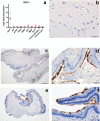Molecular Analyses Reveal Inflammatory Mediators in the Solid Component and Cyst Fluid of Human Adamantinomatous Craniopharyngioma
- PMID: 28859336
- PMCID: PMC6005018
- DOI: 10.1093/jnen/nlx061
Molecular Analyses Reveal Inflammatory Mediators in the Solid Component and Cyst Fluid of Human Adamantinomatous Craniopharyngioma
Abstract
Pediatric adamantinomatous craniopharyngioma (ACP) is a highly solid and cystic tumor, often causing substantial damage to critical neuroendocrine structures such as the hypothalamus, pituitary gland, and optic apparatus. Paracrine signaling mechanisms driving tumor behavior have been hypothesized, with IL-6R overexpression identified as a potential therapeutic target. To identify potential novel therapies, we characterized inflammatory and immunomodulatory factors in ACP cyst fluid and solid tumor components. Cytometric bead analysis revealed a highly pro-inflammatory cytokine pattern in fluid from ACP compared to fluids from another cystic pediatric brain tumor, pilocytic astrocytoma. Cytokines and chemokines with particularly elevated concentrations in ACPs were IL-6, CXCL1 (GRO), CXCL8 (IL-8) and the immunosuppressive cytokine IL-10. These data were concordant with solid tumor compartment transcriptomic data from a larger cohort of ACPs, other pediatric brain tumors and normal brain. The majority of receptors for these cytokines and chemokines were also over-expressed in ACPs. In addition to IL-10, the established immunosuppressive factor IDO-1 was overexpressed by ACPs at the mRNA and protein levels. These data indicate that ACP cyst fluids and solid tumor components are characterized by an inflammatory cytokine and chemokine expression pattern. Further study regarding selective cytokine blockade may inform novel therapeutic interventions.
Keywords: Adamantinomatous craniopharyngioma; Craniopharyngioma cyst; Cytokine; IL-6; Immunomodulation; Inflammatory.
© 2017 American Association of Neuropathologists, Inc. All rights reserved.
Figures





References
-
- Meuric S, Brauner R, Trivin C et al. , Influence of tumor location on the presentation and evolution of craniopharyngiomas. J Neurosurg 2005;103:421–6 - PubMed
-
- Elowe-Gruau E, Beltrand J, Brauner R et al. , Childhood craniopharyngioma: Hypothalamus-sparing surgery decreases the risk of obesity. J Clin Endocrinol Metab 2013;98:2376–82 - PubMed
-
- Cavalheiro S, Di Rocco C, Valenzuela S et al. , Craniopharyngiomas: Intratumoral chemotherapy with interferon-alpha: A multicenter preliminary study with 60 cases. Neurosurg Focus 2010;28:E12 - PubMed
Publication types
MeSH terms
Substances
Grants and funding
LinkOut - more resources
Full Text Sources
Other Literature Sources
Medical
Molecular Biology Databases
Research Materials

